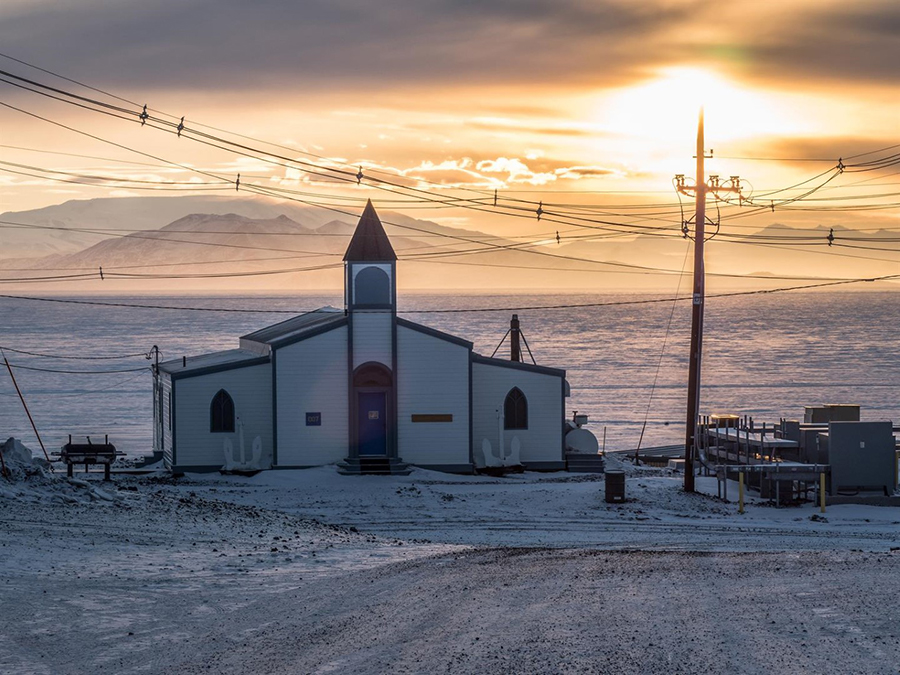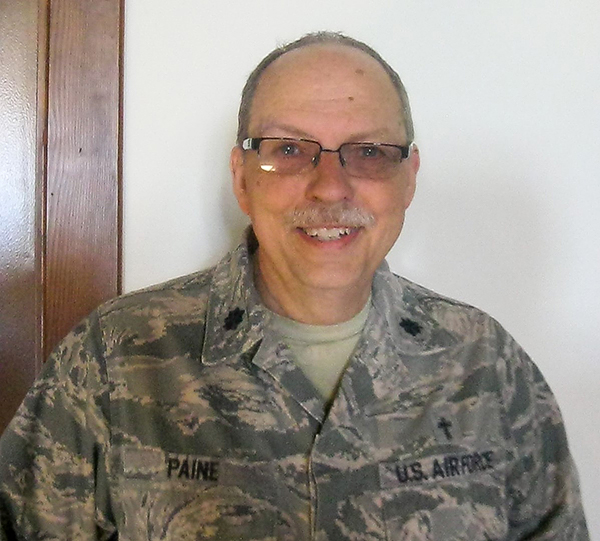
Photo Credit: Tien Lai
|
The sun sets behind McMurdo Station's Chapel of the Snows. The non-denominational chapel is a place where people of all faiths and
backgrounds can come together for worship or guidance.
|
Building People Up at McMurdo's Chapel
The Stewardship of the Chapel of the Snows
By Elizabeth Delaquess,
Antarctic Sun Guest Writer
Posted December 15, 2017

Photo Credit: Elizabeth Delaquess
Chaplain Arthur 'Tom' Paine was the first chaplain stationed at McMurdo's Chapel of the Snows this season.
Situated at the end of town, McMurdo Station’s small, blue and white Chapel of the Snows stands out against the
comparatively drab shipping container-like structures surrounding it. Visitors who step inside the wooden building
enter a cozy sanctuary, complete with shelves full of hymnals, musical instruments at the back of the room, and
a stained glass window above the pulpit. Other than the black and white penguin embedded in the stained glass,
it looks much like any small church in the United States. However, Chaplain Arthur “Tom” Paine says the chapel
provides more than weekly Christian worship.
“This chapel is for everybody,” he said.
The U.S. Antarctic Program brings people of all faiths and religious backgrounds together to support science at
the bottom of the world. During the peak of the austral summer, more than 900 people work at McMurdo Station,
the largest of the three National Science Foundation-managed stations. Months-long deployments away from home
can be difficult for many and the station’s chapel is there to provide a place for people to find personal support
and guidance if they need it.
In addition to holding a multi-denominational Christian worship service every Sunday from October through February,
the chapel currently hosts a weekly hour-long Vipassana Buddhist meditation, Alcoholics Anonymous Meetings and
a weekly Ted Talk video discussion series. People stop by to pray or meditate, and to regroup before heading
home, to the South Pole or whatever field site they’re traveling to.

Photo Credit: Elizabeth Delaquess
The small black and white penguin and outline of the continent in the chapel’s stained glass window are some of the details unique to McMurdo’s Chapel of the Snows.
He said the musical instruments, used in worship services, are another popular feature.
“This is kind of like instrument central,” he said with a laugh. “We’ve got three guitars, a piano, an organ, and
two keyboards, and people come in and they all say the same thing: They say, ‘I’m not that good of a musician,’
and they all start playing and they’re all pretty good musicians.”
Talented musicians aside, Paine said that the diversity of backgrounds and beliefs held by people at McMurdo make
his job especially rewarding.
“As a chaplain, my job is to say, ‘What do you believe, and how can I help you practice that,’” he said. “I get
to meet people from every perspective you can imagine.”
He also appreciates seeing a wide range of denominations worshipping together, something which is “highly unusual”
for the average church in the United States.
“It’s an unfortunate aspect of spiritual life, that spiritual groups don’t get together enough. They focus on what
they disagree on more than what they agree on, and there’s so much we have in common that we can work on together,”
Paine said.
Paine is a member of the Air National Guard who serves two congregations back home in New Orleans. This is his
first time at McMurdo Station and he’s the first of three chaplains on rotation for the summer season. He said
the scientific research and focus on community is what initially drew him to McMurdo.
“I have always been fascinated by places that build people up. In such an environment, you have to work together.
It’s inevitable that it’s community based,” Paine said.
He has not been disappointed.
“There’s so much to be learned here,” he said. “I’ve met radio astronomers, people doing ice dives, wildlife biologists.
Learning how to preserve life and how life has adapted to this extreme environment is incredible knowledge to
be gained.”
He added that community spirit at the station has been a source of inspiration for him.
“You don’t come out here [to Antarctica] and do this by yourself,” he said. “It’s not a solo venture. It’s communal.
I find that edifying.”







